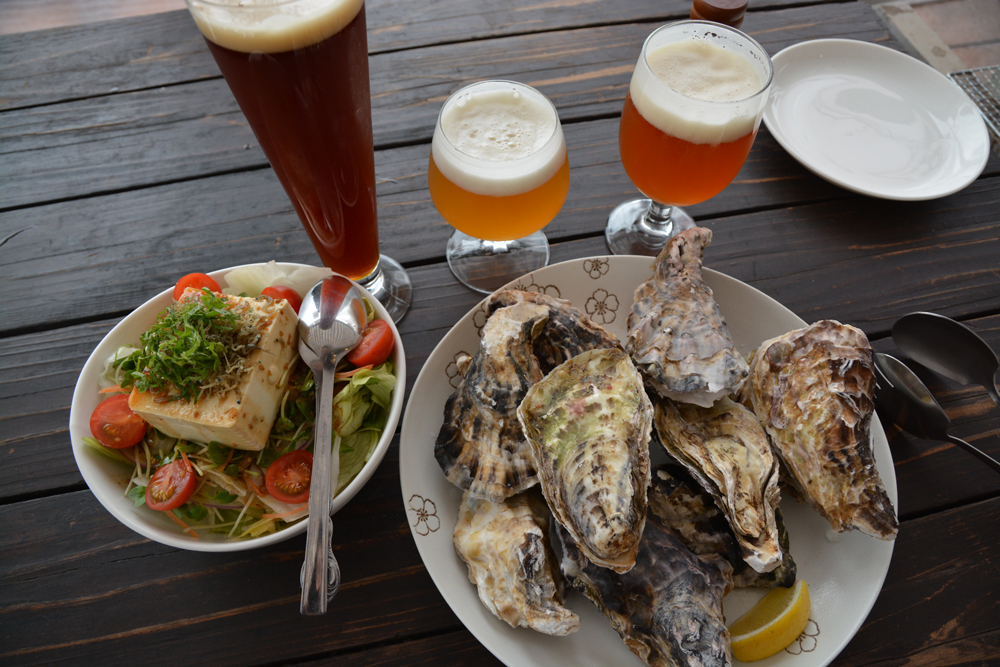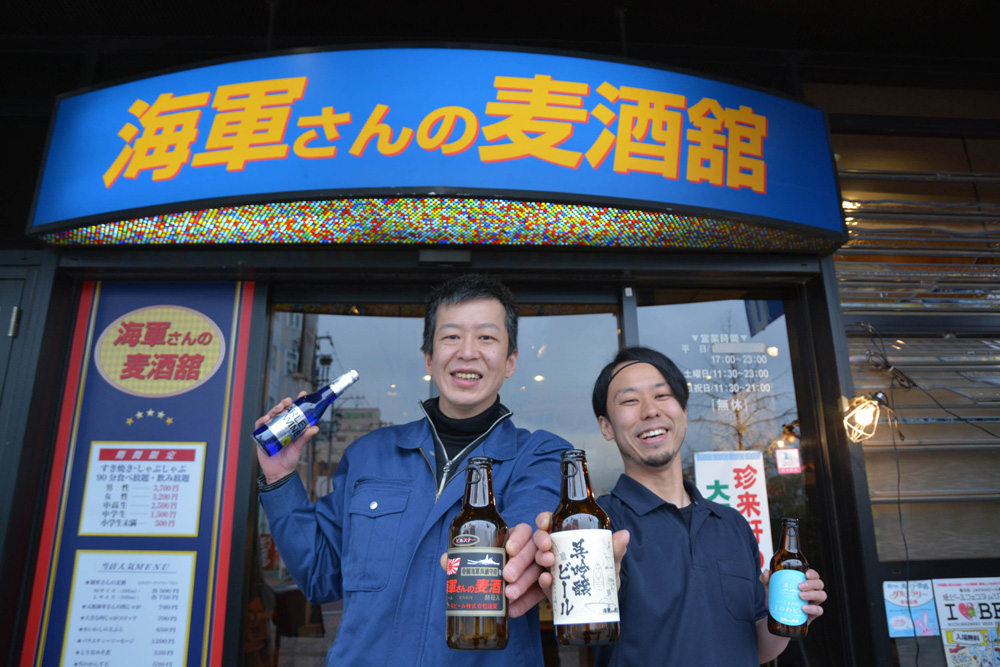Kure City is nationally known for having a one-tenth scale replica of the WWII battleship Yamato, the largest ever built. The city is just a thirty-minute train ride from Hiroshima and attracts tourism from all over the country. The city’s local beer, brewed by Kure Beer Company, is (Navy Beer).
The company was founded in July of 1995 with funds from roughly 250 area businesses, in particular the Kure City Chamber of Commerce. The consortium hoped to raise the profile of the city and also spark some industry. Each successive director of the company has also chaired the Chamber of Commerce and the beer remains a locally-financed venture (there’s a similar case with Okhotsk Beer in Kitami City, Hokkaido).
Kaigun-san no Bakushu is a fairly well-known brand among beer fans now, but it was initially named Clair by the public, along with the brewery restaurant. This is the French word for “clear” and was intended as a pun on “Cheer for Kure” (pronounced similarly in Japanese to “clair”). “Cheer”, incidentally, is also a homonym for “ale” in Japanese. In reality Kure Beer pursued German beer styles, including a pilsner (a German, as opposed to Czech, variety), helles, weizen, alt and a bottom-fermenting lager.
The brewery restaurant, Beer Hall Clair, opened on May 29th, 1996. The company invited a brewer from Germany for a year and a half to teach brewing technique. For a while after its opening, throngs of people lined up excitedly outside its doors. By November of that first year, it had attracted 53,000 guests according to some surviving records. The brewery had estimated that it would brew twenty kiloliters that year, but the final tally was sixty-five. Partly facilitating that was the August opening in nearby Hiroshima City of Münster, a restaurant that served Kure’s alt, weizen and pilsner. Then in December, the company opened Clair Hondori (“mainstreet”) Store in Kure City, where it offered a seasonal bock beer.
The current brewer, Sasaki Masaharu, started working for the company in 1997, but as a member of the restaurant’s waiting staff. Before joining the company he had tried some of Beer Hall Clair’s beer and had taken a liking in particular to the pilsner. “Until then, I had never drunk a pilsner with such great aroma,” he recounts.
After about a year on the job, there weren’t enough hands to help out with the brewing so he was brought into that team. One year after that, the head brewer left and he was asked if he wanted to give it a try. He accepted right away, becoming the brewery’s fourth brewmaster. “For me, though, this was the start of trouble,” says Sasaki. “I had a basic understanding of how to make beer from my experience working there, but I didn’t really know anything about making good beer.” Nor could he determine what the cause of a poorly brewed batch of beer might be.
It got worse; the restaurant was understaffed and he was asked to look after these operations in the capacity of a manager. If this were a brewpub, it might not have been so tall a task, but this was a full-blown restaurant with some two hundred seats. This was way beyond the level of peripheral management. As a result, he was never able to find the time to hone his skills and the complaints started trickling in. A common refrain was: “The beer is no longer as good as when the German brewer was here.” Sasaki notes, “I was way too afraid of telling people that it was my beer.” Sasaki calls these few years his period of darkness.
Toward the end of the 1990s, the whole local beer boom fizzled out and many breweries faced closure. Kure Beer was one whose prospects looked dim. Sasaki, at his limits trying to run both the brewery and the restaurant, was still unable to hire more employees. Nevertheless, the quality of the beers started improving in increments. Sasaki attributes this to, “Not letting things get to me. And a focus on results whereby I improved slowly but surely.” For starters, he didn’t undertake any crazy new approaches. He adopted a policy of refining those things he knew he could. From there, he was able to develop a kind of comfort zone and make beer that he treated on par with perishable food.
Sasaki was able to find additional support along his path to improvement through the Chugoku Craft Beer Conference, which was launched in 1998. This was a gathering whose ultimate objective was to enable participating breweries to achieve higher quality products. The conference enabled valuable exchanges, and Sasaki was able to consult extensively with Iwata Hideki, of Daisen-G Beer, and Yano Manabu, of Beer Hearn. Some local business shareholders also threw some sales support behind Sasaki, encouraging him to host the conference banquet at Clair.
In 1999 the company finally changed the beer’s brand name to “Kaigun-san no Bakushu” and the restaurant to “Kaigun-san no Bakushu-kan” (Navy Beer Hall). It also began selling bottles. Unsurprisingly, this was an attempt to rebrand and find new direction after that first beer boom ended.
The company began to see the first signs of a turnaround in 2005. The Yamato Museum opened with its breathtaking one-tenth scale replica of Yamato, drawing countless visitors to the city. At the same time, there were increasing numbers of people at the restaurant saying, “Well if there’s some local beer, I’ll try it.” Sales ticked upward. The image of “Navy Beer” fit perfectly with that of the Yamato, too. That year, for the first time since the original beer boom in the mid-90s, they surpassed sixty kiloliters of production on the year.
Around 2007 they began garnering increased praise for the flavor, too. “Prior to that, there were plenty of guests telling us our beers were good, but 2007 was certainly a watershed year in terms of the amount of praise we were getting.” Shortly thereafter in 2008, almost as a reflection of those sentiments, the brewery won two gold medals for its alt and kolsch, and a bronze for its pilsner at the International Beer Cup. This was also around the time of the inaugural Craft Beer Festival in Hiroshima, which attracted some 23,000 visitors.
The brewery continued to win awards at festivals thereafter and it began to develop seasonal offerings one after another as well. Inspired by Daisen-G, it released a barley wine in 2009. The following year, it released its unique Kure Ginjo Beer, which used a Ginjo (premium sake) yeast from Hiroshima. It didn’t make its first pale ale until 2013, but launched another unusual and highly lauded beer in 2014: Shimanowa.
The name draws attention to a shared sense of community in the islands between Hiroshima and Ehime prefectures. The beer was brewed using Hiroshima’s prized lemons and Ehime’s Mandarin oranges. Kaigun-san no Bakushu, however, didn’t have a happoshu (beer with additives) license so it couldn’t legally brew anything with fruit added. Instead, it started with its pilsner and simply added hops with citrusy aroma. To further invoke images of the Inland Sea area with all its gorgeous sunshine, the brewery used four different kinds of malt and produced a reddish hue in the beer. The result was a wonderfully drinkable “session India pale lager.”
Masuda Hiroyuki is another member of the core brewing team who came on board in 2008 after first working part-time for the company from 2003. When he first joined the company he didn’t have that much interest in brewing, but several years later drank a Brewdog Punk IPA and was hooked by the flavor. “I was shocked,” he said, “that one beer could provide this much excitement. I began to wonder if I couldn’t brew something like that one day, too.” He soon found himself a slave to hop-forward beer, explaining why so many of their seasonal offerings are hoppy. Currently, Masuda is mainly in charge of the brewhouse and proclaims, “I want to keep making these hoppy seasonals while also expanding our variety.”
To taste some of Kaigun-san no Bakushu’s offerings, you don’t need to stray far from JR Kure Station; the brewery’s restaurant is close by. It’s probably worth visiting the Yamato Museum, too, which is along the way. In the winter months, definitely try some of the local oysters. In nearby Hiroshima city, the bars Golden Garden and Raku Beer both carry the beers. Of course I recommended that you visit all of them!
This article was published in Japan Beer Times # () and is among the limited content available online. Order your copy through our online shop or download the digital version from the iTunes store to access the full contents of this issue.





